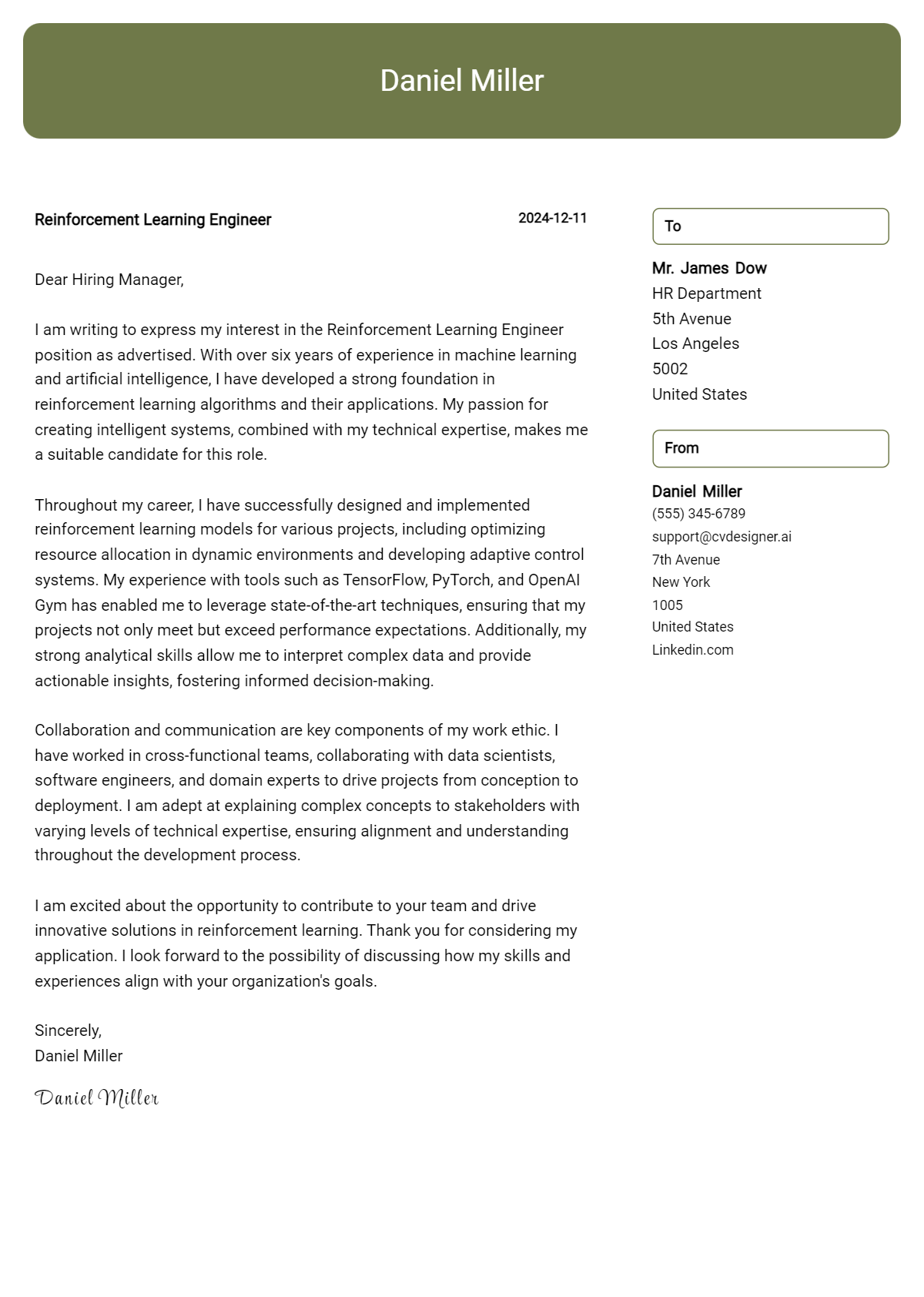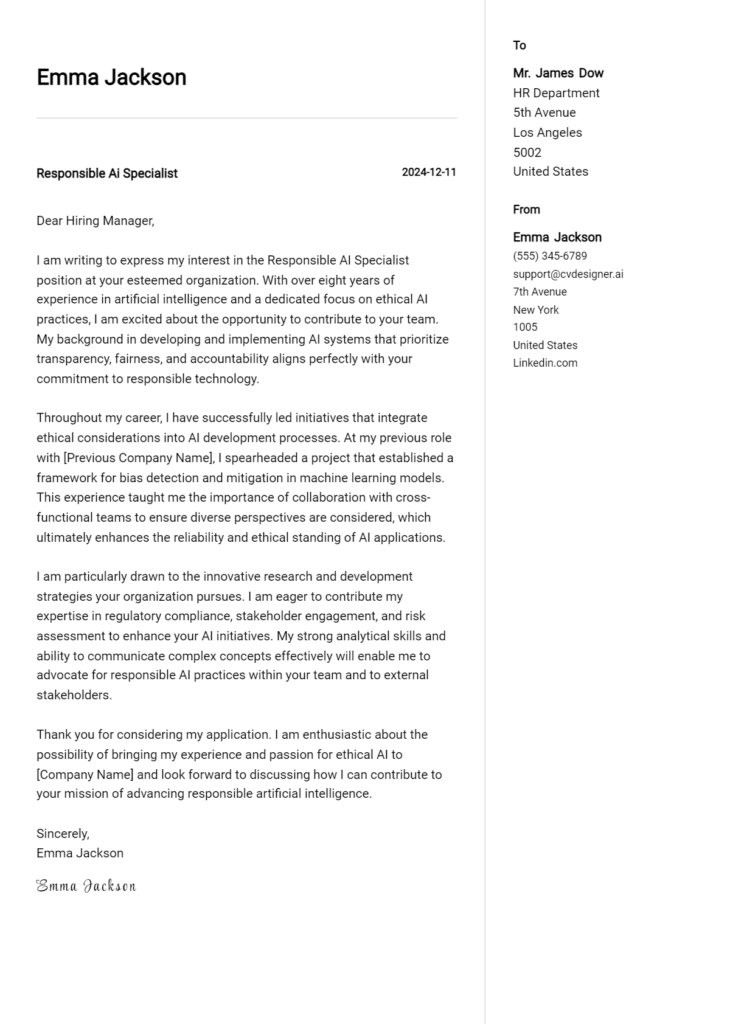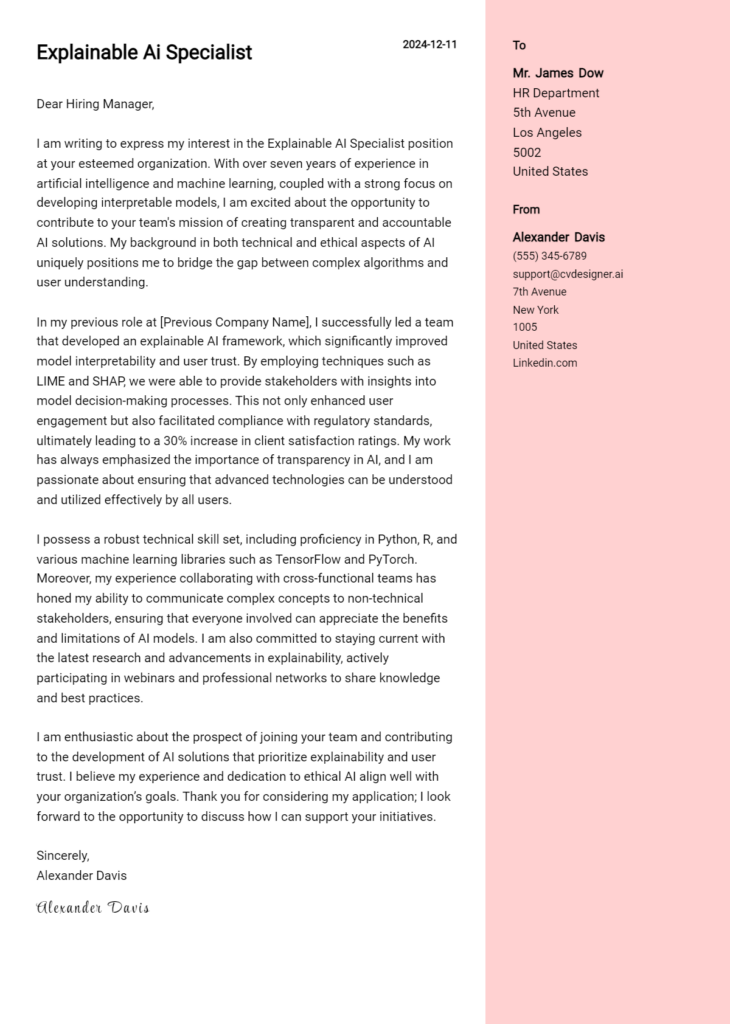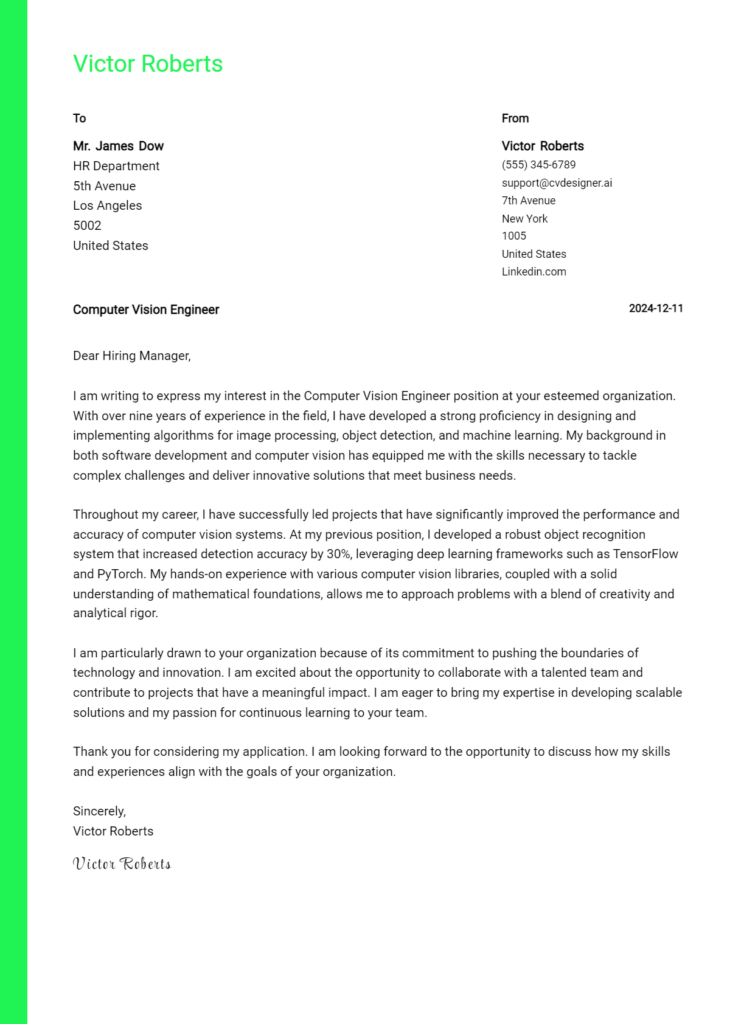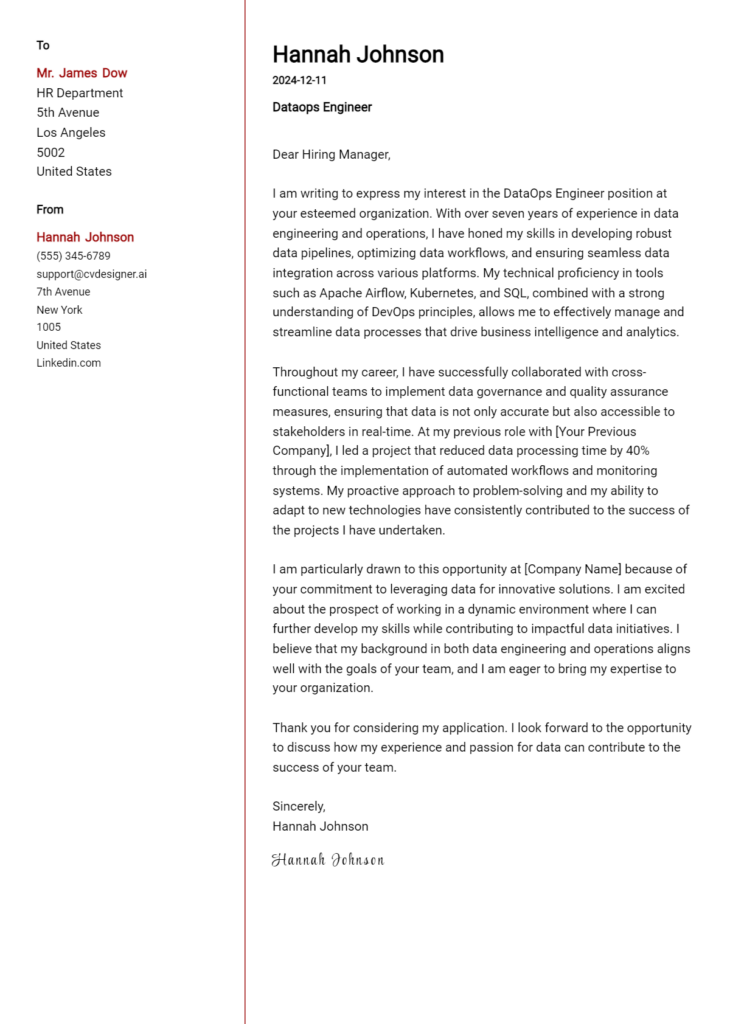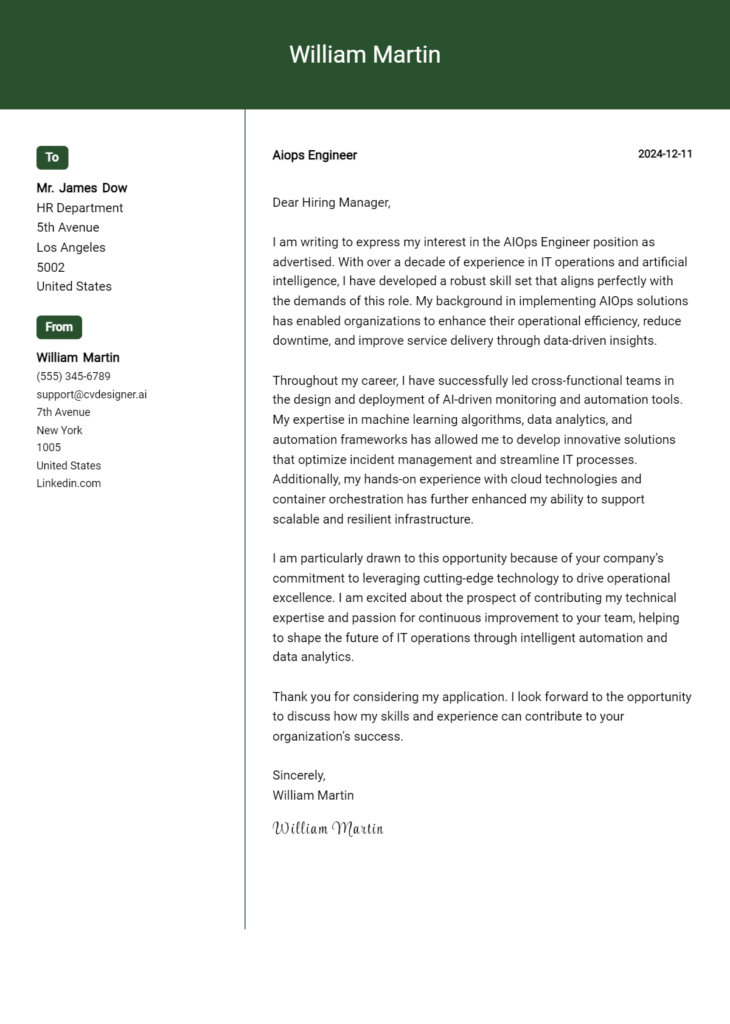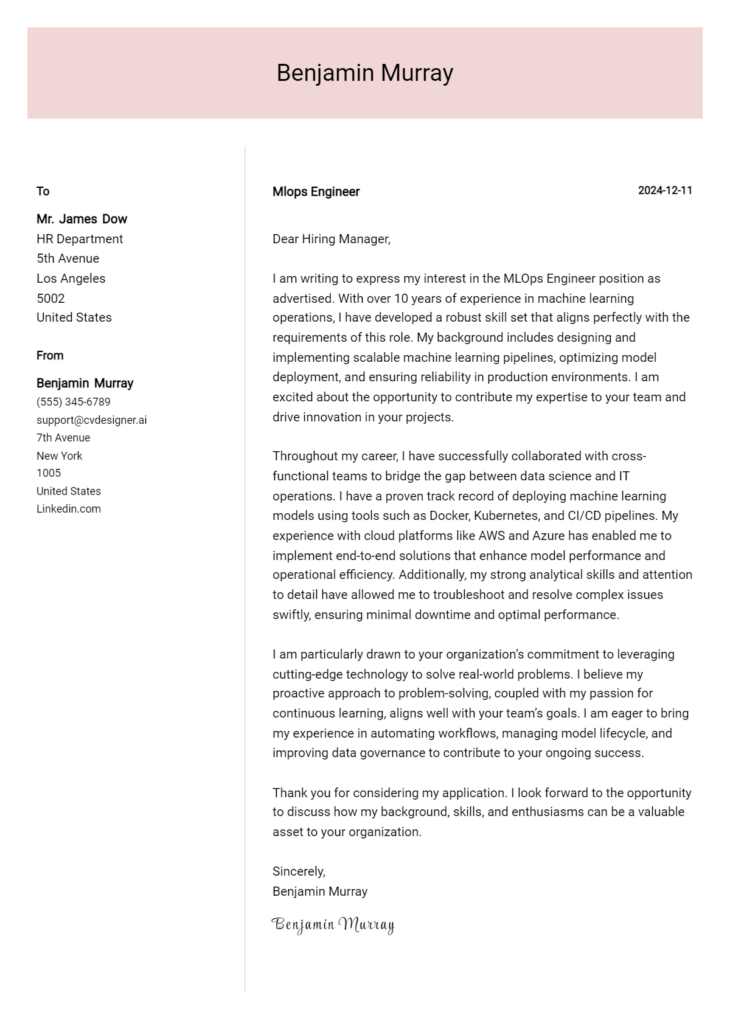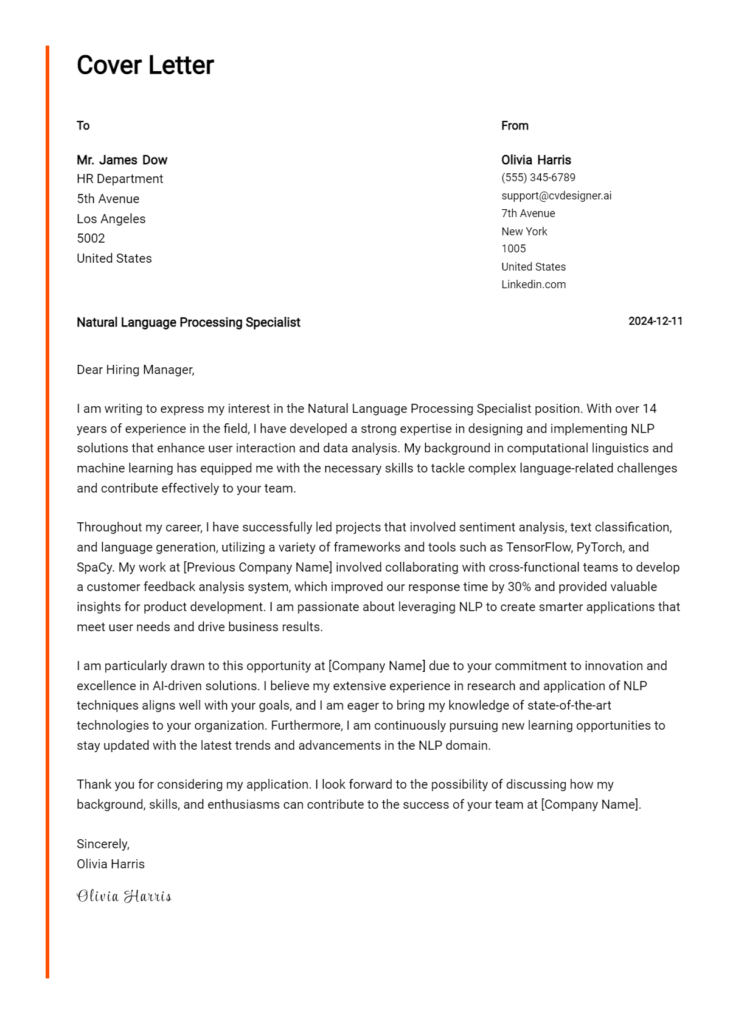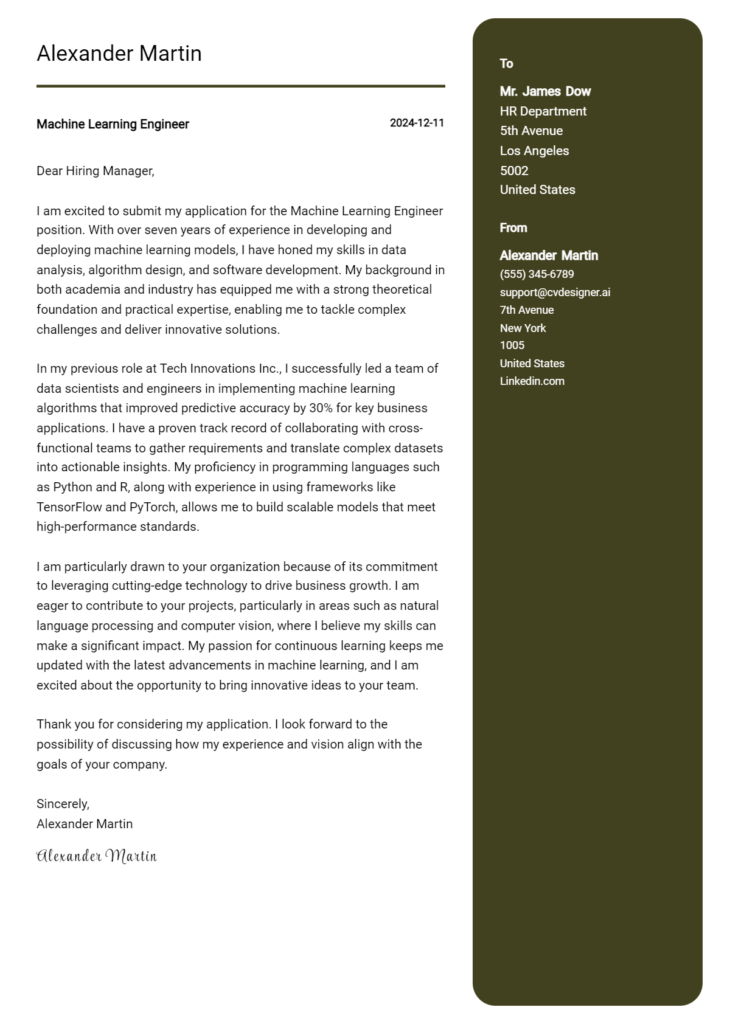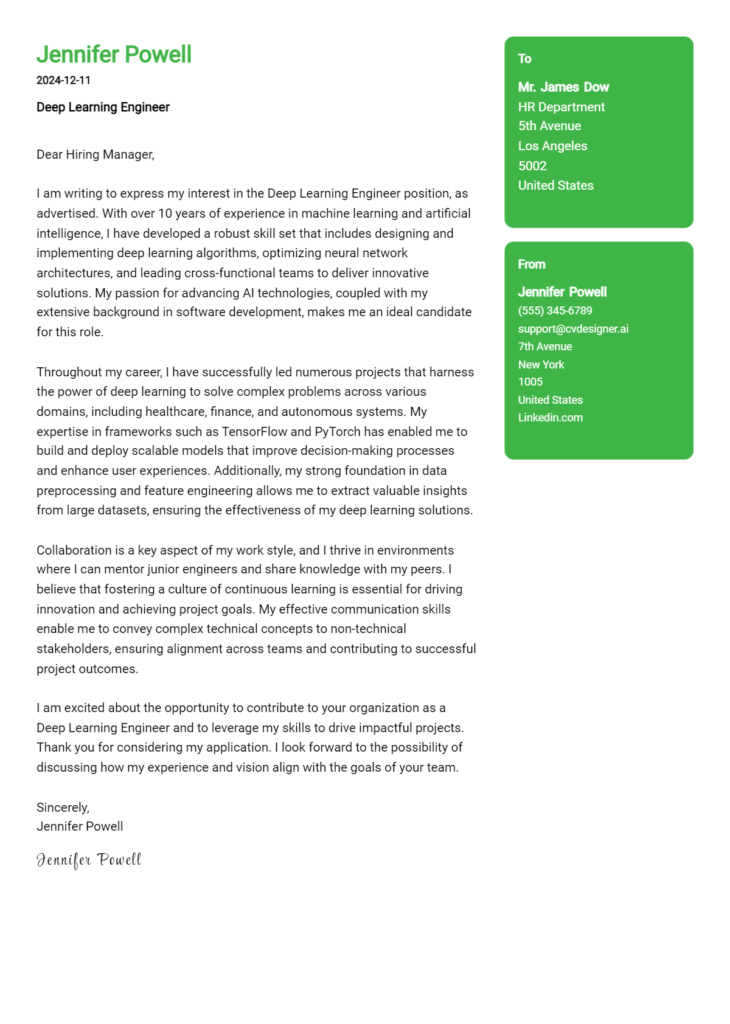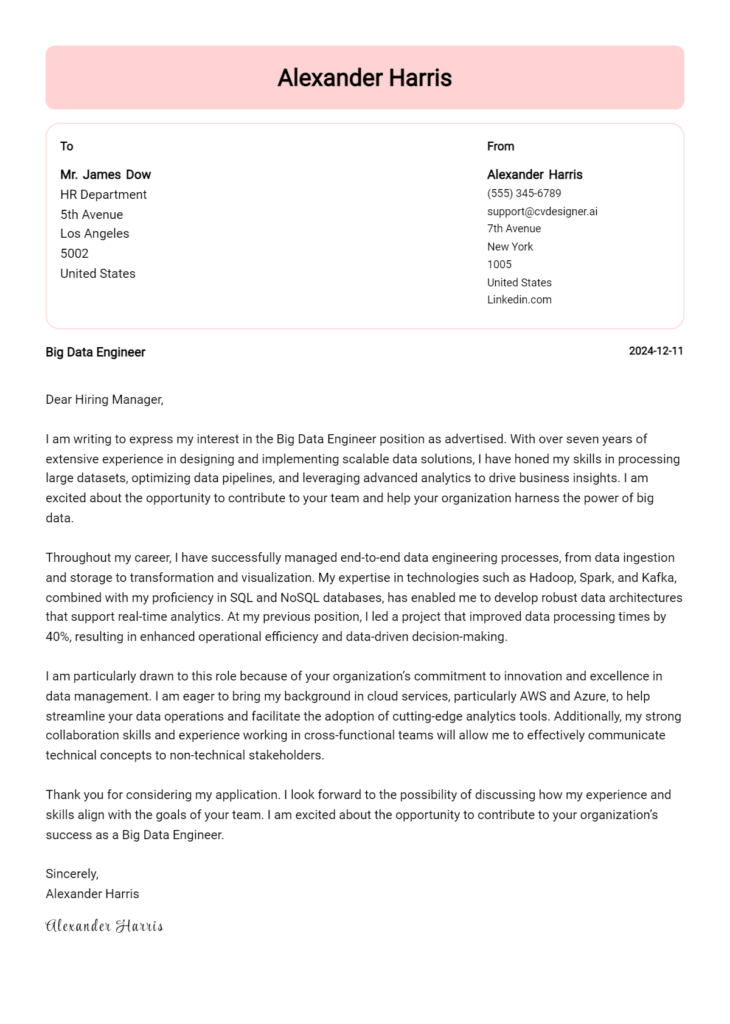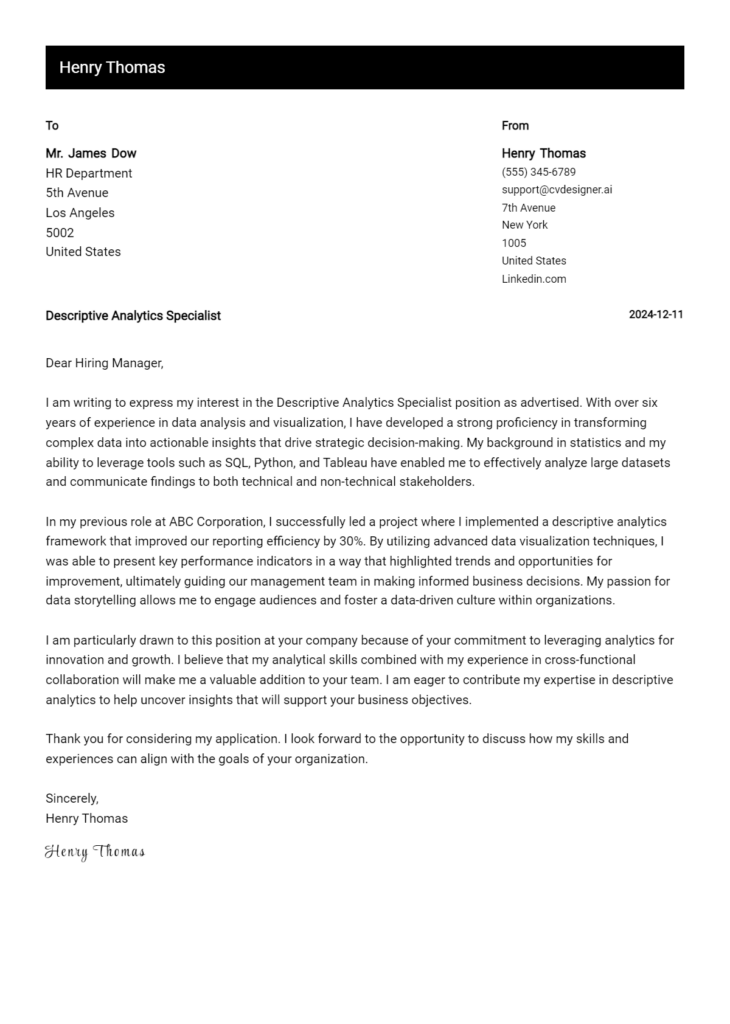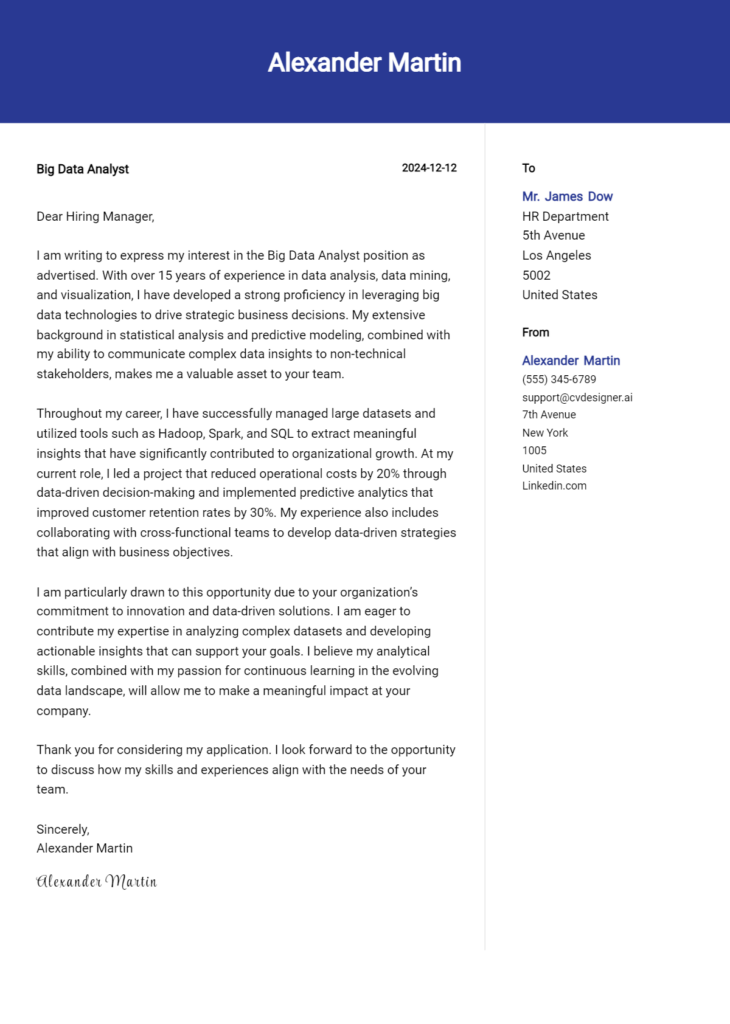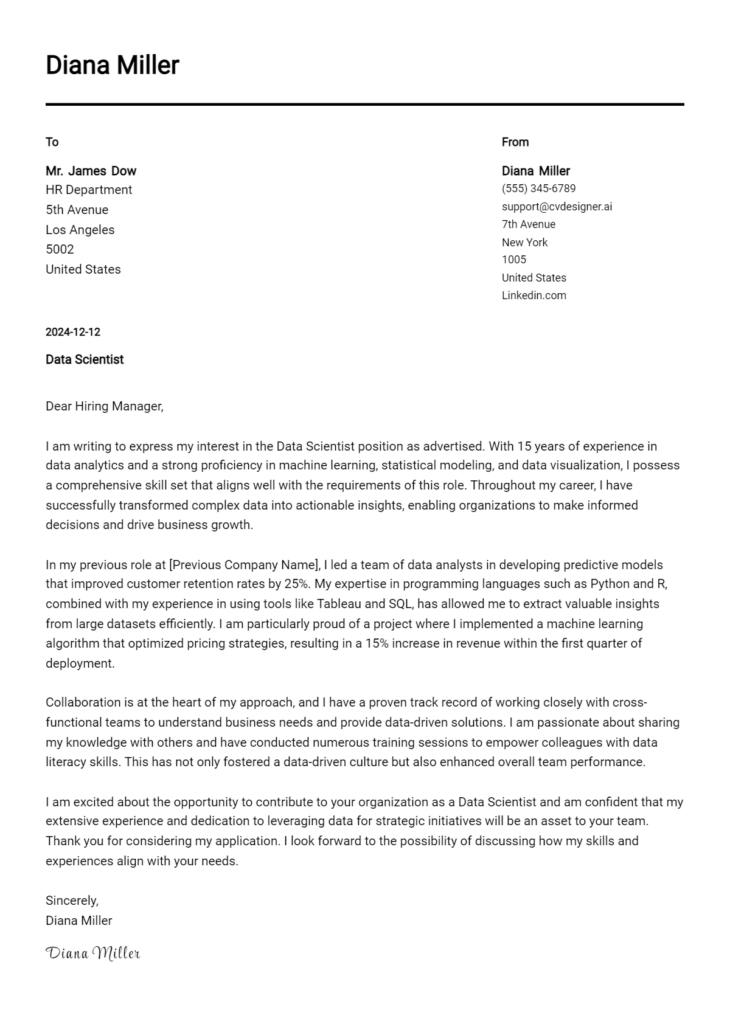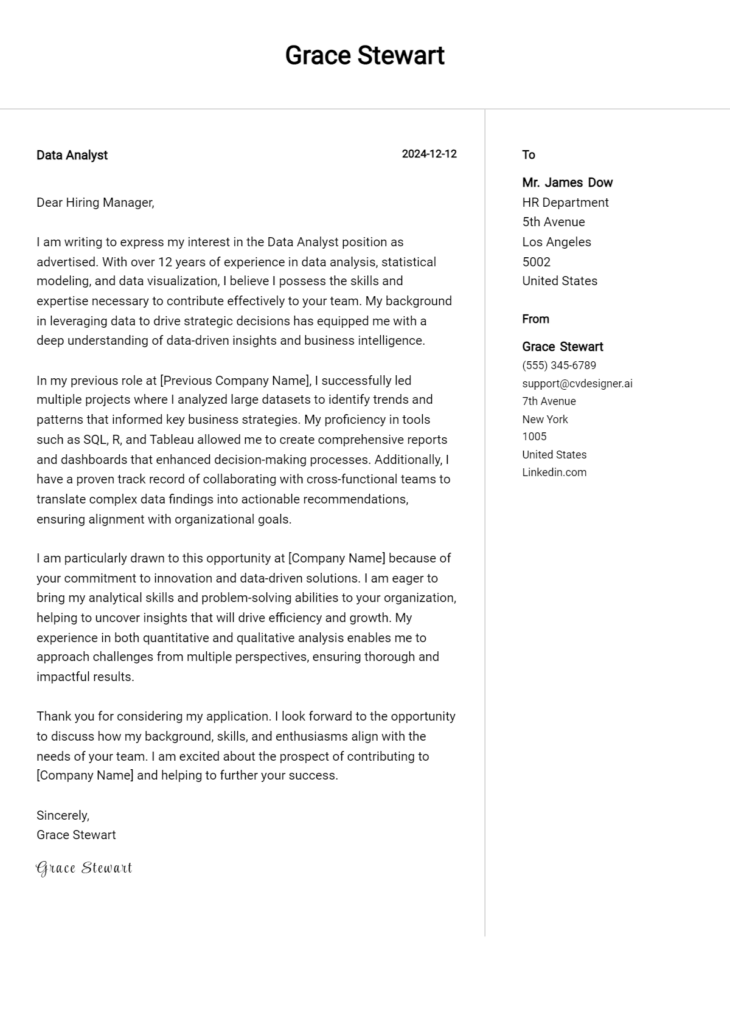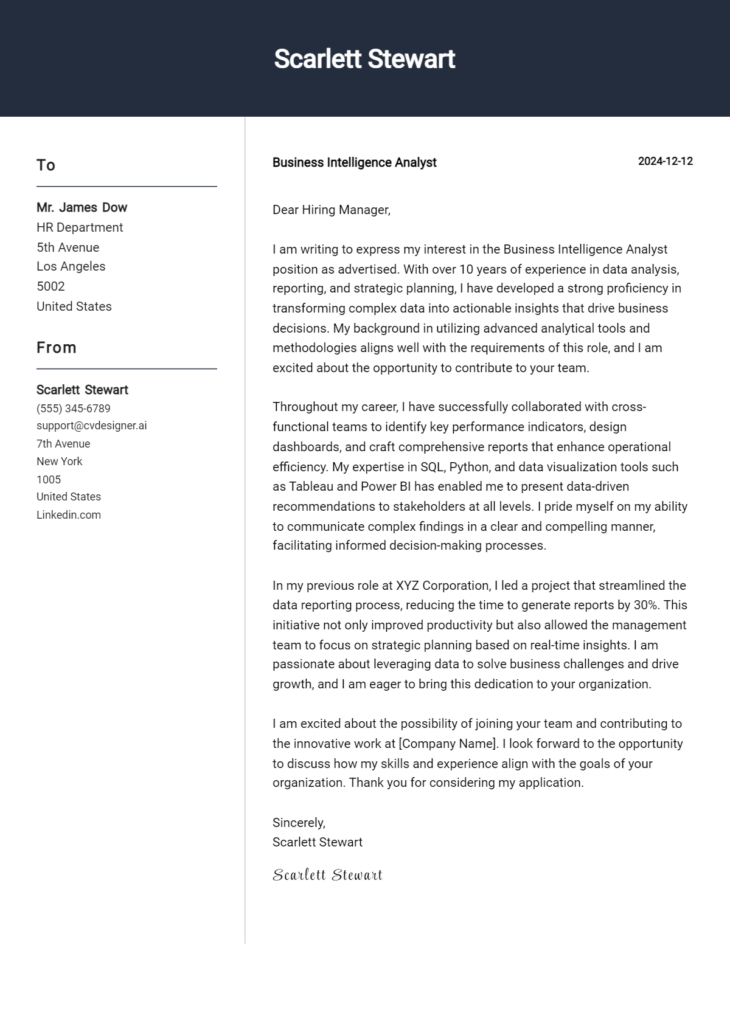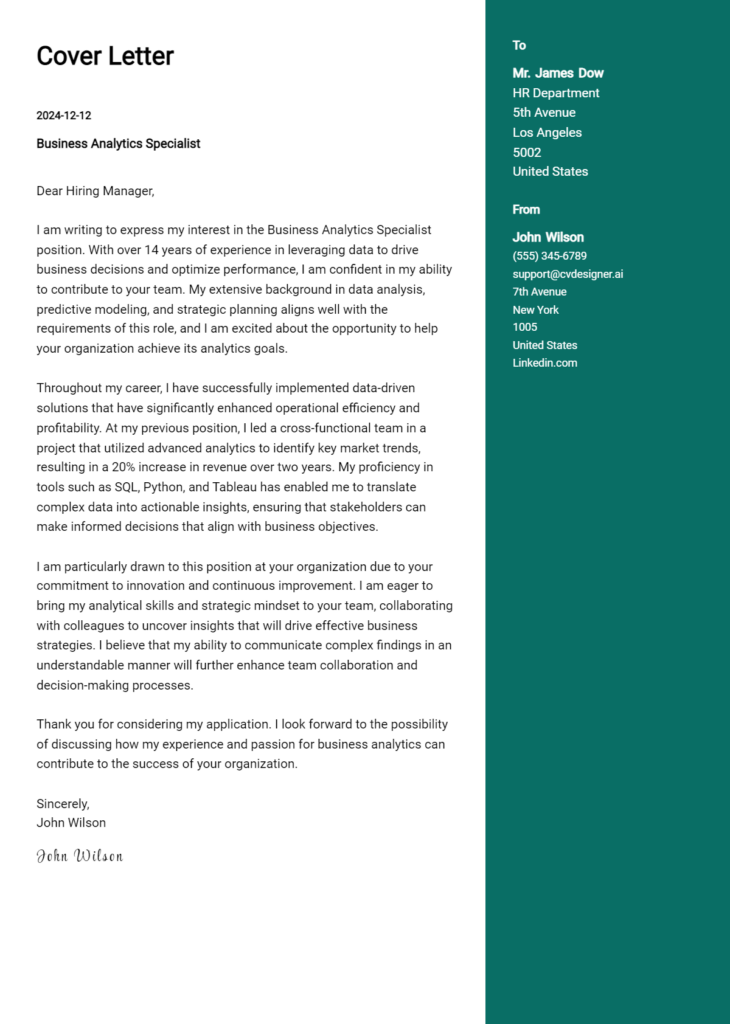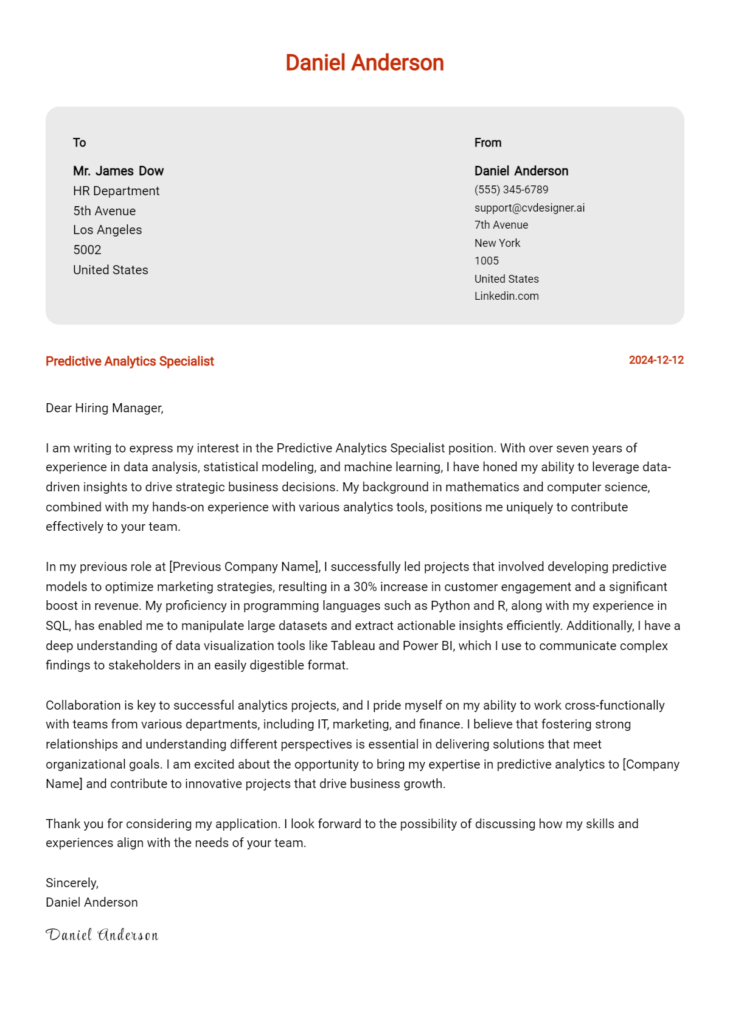Reinforcement Learning Engineer Cover Letter Examples
Explore additional Reinforcement Learning Engineer cover letter samples and guides and see what works for your level of experience or role.
How to Format a Reinforcement Learning Engineer Cover Letter?
Crafting a compelling cover letter is essential for a Reinforcement Learning Engineer, as it serves as your first opportunity to demonstrate not only your technical prowess but also your analytical skills and innovative thinking. The formatting of your cover letter is crucial; it reflects your ability to organize complex information and communicate effectively—qualities that are vital in the field of machine learning. A well-structured cover letter will capture the attention of hiring managers, allowing you to showcase your unique blend of expertise and creativity.
In this guide, we will outline how to construct your cover letter, providing insights and examples tailored for the reinforcement learning domain.
We'll focus on the essential components of a professional cover letter, including:
- Cover Letter Header
- Cover Letter Greeting
- Cover Letter Introduction
- Cover Letter Body
- Cover Letter Closing
Each section plays a significant role in accentuating your qualifications and professionalism. Let’s break down each part and explain how to make your Reinforcement Learning Engineer cover letter stand out.
Importance of the Cover Letter Header for a Reinforcement Learning Engineer
The header of a cover letter is a crucial component, as it sets the tone for the entire document and establishes a professional first impression. For a Reinforcement Learning Engineer, clarity and professionalism in the header are essential, as they reflect attention to detail and a strong understanding of industry standards. The header should include your contact information, the date of writing, and the recipient's details, ensuring that the hiring manager can easily reach you. A well-structured header enhances the readability of your cover letter and demonstrates your ability to communicate effectively.
Strong Example
John Doe 1234 Machine Learning Ave Tech City, ST 12345 john.doe@email.com (123) 456-7890 March 15, 2023 Jane Smith Hiring Manager Innovative AI Solutions 5678 Data Road Tech City, ST 12345
Weak Example
jd1234@gmail.com March 15 To Whom It May Concern
The Importance of a Personalized Greeting in Your Cover Letter
The greeting of your cover letter is more than just a formality; it sets the tone for the entire letter and establishes your professionalism and attention to detail. A well-crafted greeting can create a positive first impression, demonstrating your eagerness and respect for the recipient. By addressing the hiring manager directly, you personalize your application, showing that you have taken the time to research and understand the company and its culture. To make your greeting impactful, it's crucial to avoid generic phrases like "To Whom It May Concern." Instead, invest a little time in finding out the hiring manager's name, which can often be done through the company's website or LinkedIn. This small effort can convey your genuine interest in the position and differentiate you from other candidates.
Strong Greeting Example
Dear Dr. Smith,
Weak Greeting Example
To Whom It May Concern,
Importance of a Well-Crafted Cover Letter Introduction for a Reinforcement Learning Engineer
A well-crafted cover letter introduction is crucial for a Reinforcement Learning Engineer as it serves as the first impression to the hiring manager. This opening paragraph should effectively capture attention, express genuine interest in the position, and highlight key skills or achievements that align with the job requirements. A strong introduction sets the tone for the rest of the cover letter and establishes the candidate's enthusiasm and suitability for the role. In contrast, a weak introduction may fail to engage the reader, missing the opportunity to showcase the candidate's potential value to the team. Below are examples of both strong and weak cover letter introductions for a Reinforcement Learning Engineer.
Strong Example
Dear Hiring Manager, I am excited to apply for the Reinforcement Learning Engineer position at [Company Name], where I can leverage my extensive experience in developing advanced machine learning algorithms to optimize decision-making processes. My recent project on creating a state-of-the-art reinforcement learning model for autonomous vehicle navigation not only improved efficiency by 30% but also showcased my ability to tackle complex challenges in real-time environments. I am eager to bring my passion for AI and my innovative problem-solving skills to your esteemed team.
Weak Example
To whom it may concern, I am writing to apply for the Reinforcement Learning Engineer position. I have some experience in machine learning and think I could be a good fit. I hope to discuss my qualifications further.
Purpose of the Cover Letter Body for a Reinforcement Learning Engineer
The body of a cover letter for a Reinforcement Learning Engineer serves as a platform for candidates to articulate their specialized skills, relevant experiences, and the unique value they bring to the prospective employer. This section should effectively highlight specific projects, such as successful implementations of reinforcement learning algorithms, participation in competitions, or contributions to open-source projects, illustrating the candidate's technical proficiency and problem-solving capabilities. By showcasing accomplishments and quantifiable results, the candidate can demonstrate their potential impact on the company's goals and initiatives.
Strong Example
I am excited to apply for the Reinforcement Learning Engineer position at XYZ Company. In my previous role at ABC Corp, I successfully developed a reinforcement learning model that optimized real-time decision-making for a logistics application. This project not only improved operational efficiency by 30% but also reduced costs significantly. Additionally, I participated in the Kaggle Reinforcement Learning competition, where my team secured a top 10% finish by implementing advanced algorithms such as Proximal Policy Optimization and Deep Q-Networks. My hands-on experience with TensorFlow and PyTorch, combined with a solid understanding of Markov Decision Processes, allows me to contribute effectively to innovative projects at XYZ Company.
Weak Example
I am applying for the Reinforcement Learning Engineer position. I have some experience in machine learning and have worked on various projects. I think I can help your team. I know a bit about reinforcement learning, but I haven't worked on any specific projects that used it. I have a general understanding of programming languages and have taken some online courses, but I haven’t implemented anything significant.
Importance of the Cover Letter Closing for a Reinforcement Learning Engineer
The closing paragraph of a cover letter is crucial as it encapsulates your qualifications, reiterates your enthusiasm for the position, and prompts the employer to take the next steps, such as reviewing your resume or scheduling an interview. A strong closing leaves a lasting impression and demonstrates your professionalism and sincerity, while a weak closing may fail to convey your interest or make a compelling case for your candidacy. Below are examples of both strong and weak closing paragraphs.
Strong Example
Thank you for considering my application for the Reinforcement Learning Engineer position at [Company Name]. With my extensive experience in developing robust RL algorithms and my passion for advancing machine learning technologies, I am excited about the opportunity to contribute to your innovative team. I look forward to discussing how my skills align with your goals and would appreciate the chance to further explore this role. Please feel free to review my resume, and I hope to hear from you soon to schedule an interview.
Weak Example
I hope you think about my application for the Reinforcement Learning Engineer job. I have some relevant experience and would like to work at your company. Please look at my resume. Thanks.
These tips will help candidates craft an effective cover letter for a Reinforcement Learning Engineer position, emphasizing the importance of showcasing technical skills, problem-solving abilities, knowledge of the Software Development Life Cycle (SDLC), teamwork, and a passion for continuous learning. A well-structured cover letter can set you apart from other candidates and demonstrate your suitability for this complex and dynamic role.
Tips for Crafting an Effective Cover Letter
Highlight Your Technical Skills
Begin your cover letter by explicitly mentioning your technical expertise in reinforcement learning algorithms, programming languages (like Python or Java), and tools (such as TensorFlow or PyTorch). Provide specific examples of projects or research where you applied these skills to solve real-world problems. This not only showcases your qualifications but also demonstrates your hands-on experience.Demonstrate Problem-Solving Abilities
Reinforcement Learning Engineers often tackle challenging problems. Use your cover letter to describe a particular challenge you faced in a project and how you approached it. Discuss the methods you used to evaluate various solutions and detail the outcomes. This narrative will illustrate your critical thinking and problem-solving capabilities effectively.Show Knowledge of the Software Development Life Cycle (SDLC)
Mention your familiarity with the SDLC, emphasizing your ability to work through various phases, including requirements gathering, design, implementation, testing, and maintenance. Highlight any experience you have in Agile or DevOps environments, as these methodologies are increasingly relevant in machine learning projects.Emphasize Teamwork and Collaboration
Reinforcement learning projects often require collaboration with cross-functional teams. In your cover letter, provide examples of how you worked alongside data scientists, software engineers, or domain experts. Discuss your role in fostering communication and collaboration, which is essential for the successful deployment of machine learning models.Express a Passion for Continuous Learning
The field of reinforcement learning is rapidly evolving, and employers value candidates who are committed to ongoing education. Mention any recent courses, certifications, or conferences you’ve attended related to AI and machine learning. This demonstrates your proactive approach to staying updated with industry trends and enhances your appeal as a candidate.
For more resources, check out our cover letter templates and consider using our cover letter builder to help streamline the writing process. Good luck with your application!
Common Mistakes to Avoid in a Reinforcement Learning Engineer Cover Letter
Avoiding common mistakes in your cover letter is essential for standing out as a candidate for a Reinforcement Learning Engineer position. A well-crafted cover letter can set you apart from the competition, while errors can diminish your chances of getting noticed. Here are some common pitfalls to avoid:
Generic Content: Many applicants use a one-size-fits-all approach. Tailor your letter to the specific job and company by mentioning relevant projects or technologies. Personalization can significantly improve your chances.
Ignoring the Job Description: Not addressing the skills and qualifications listed in the job description is a frequent mistake. Make sure to highlight your experience with specific algorithms, tools, or frameworks mentioned in the listing.
Lack of Specific Examples: Failing to provide concrete examples of your achievements can weaken your case. Use metrics or results from previous projects to demonstrate your impact in the field of reinforcement learning.
Poor Formatting: A cluttered or unprofessional format can detract from your message. Follow proper cover letter format guidelines to ensure clarity and professionalism.
Neglecting to Proofread: Spelling and grammatical errors can create a negative impression. Always proofread your cover letter or ask a friend to review it before submission.
Focusing on What You Want: While it’s essential to express your goals, overly emphasizing what you want from the position can come off as self-centered. Balance this by discussing what you can bring to the organization.
Not Including a Call to Action: Ending without a strong closing statement can leave your letter flat. Encourage the reader to reach out for further discussion or express enthusiasm about the opportunity.
By steering clear of these mistakes and focusing on crafting a compelling cover letter, you can enhance your chances of landing that critical interview. For inspiration, explore some cover letter examples to see effective strategies in action.
Build your Cover Letter in minutes
Use an AI-powered cover letter builder and have your letter done in 5 minutes. Just select your template and our software will guide you through the process.

